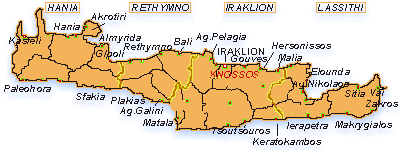In the southernmost part of Greece the island of Crete, lies in the heart of the Mediterranean Sea , separates the Aegean
from the Libyan Sea and marks the boundary between Europe Asia and Africa. The landscape of Crete is in its majority covered by mountains and deep gorges. The mostly knows in the gorge of
Samaria. The island has a few plains and the biggest are the plain of Apokoronos, Rethimno and Ierapetra. The rivers of Crete are not big, but the island has beautiful
days and is surrounded by a lot of small not-inhabited islands.
In the birthplace of Zeus, bloomed the glorious Minoan civilization
and lived great personalities of culture such as the great painter Domenicos Theotokopoulos, known as "El Greco" and Nikos Kazantzakis the author , known for his Zorba the Greek.
Known history in Crete
starts during the Neolithic ages. The beginning of the Minoan Period (2600-1100 bc) coincides with the beginning of the Bronze Age. The Minoans established a naval empire in the Mediterranean during this
period. Their civilization vanished abruptly, the most probable explanation being that the sudden eruption of the volcano in Satnorini created huge tidal waves that swept away all traces of
civilization. After that, the invasion of the Acheans and later the Dorians marked the end of the Minoan Period.
Crete was occupied at 67 BC by the Romans. Cortys, became the capital of the province
of Crete. Crete becomes part of the Byzantine Empire from 325 AD to 824 AD. The Arab occupation of Crete was a thorn in Byzantium's side and they often
tried to retake it, without success. The unsuccessful campaigns came to end in 962 when the Byzantine general Fokas captured Crete after fierce battles. This marked the
beginning of the Second Byzantine period of Crete, which ended at 1204. During the Fourth Crusade, Crete was sold to the Venetians. In 1898,
with the intervention of then Great Powers, Crete was autonomous state. Crete remained autonomous until 1913 when it united with Greece.
